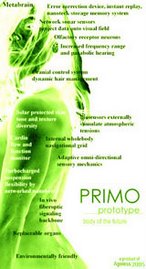Last night on eTV (South Africa’s independent broadcaster) there was a news report on Touch Bionics, the developer of the world’s first commercially available bionic hand. Touch Bionics’ i-LIMB Hand and ProDigits partial hand prostheses are now available to the general public.
Touch Bionics’ i-LIMB Hand looks and acts like a real human hand and is the world’s first widely available prosthetic device with five individually powered digits.
Touch Bionics’ ProDigits is adapted for patients who have a partial hand, due either to congenitally missing fingers or fingers lost through an accident.
With both products the amputee basically needs to think about what they want the hand/arm to do, and the hand/arm functions accordingly.
The following video is by Touch Bionics, and explains these products in detail.
Friday, July 27, 2007
Thursday, July 26, 2007
S.A's 'Blade Runner'
Oscar Pistorius, South Africa’s paralympic athlete, has had his hopes of competing in next month’s World Championships in Japan dampened, following an unfortunate incident at the British Grand Prix.
In wet conditions Pistorius, last of those who finished, was subsequently disqualified for running outside his lane. The 20-year-old South African runs on carbon fibre blades attached to both his legs below the knee and his artificial 'limbs' are currently the subject of an investigation by the International Association of Athletics Federations (IAAF). They have previously ruled that the blades are an unfair advantage but have said they will wait before making a final ruling.
I don't understand why the IAAF would think the blades give Pistorius an unfair advantage? Surely the blades can't be that advantageous if he still finds it difficult to remain in his own lane at times. Then can you imagine how challenging it must be to win a race on those things?
Below is an interview with Pistorius on the matter.
In wet conditions Pistorius, last of those who finished, was subsequently disqualified for running outside his lane. The 20-year-old South African runs on carbon fibre blades attached to both his legs below the knee and his artificial 'limbs' are currently the subject of an investigation by the International Association of Athletics Federations (IAAF). They have previously ruled that the blades are an unfair advantage but have said they will wait before making a final ruling.
I don't understand why the IAAF would think the blades give Pistorius an unfair advantage? Surely the blades can't be that advantageous if he still finds it difficult to remain in his own lane at times. Then can you imagine how challenging it must be to win a race on those things?
Below is an interview with Pistorius on the matter.
Wednesday, July 25, 2007
Welcome to 'Cyberculture'
Contemporary urban lifestyle necessitates the merger of traditional culture and technology; yielding what is commonly referred to as ‘cyberculture’.
This is evidenced in our increasing dependency on machines in carrying out our daily activities, such as waking up in the morning (alarm clock), brushing your teeth (electric toothbrush), making breakfast (stove, microwave, kettle, and toaster), etc.
In the greater scheme of things ‘cyberculture’ is primarily understood in terms of communication networks, software and programming. However, ‘cyberculture’ also constitutes “artificial intelligence, virtual reality, artificial life, and the human-computer interface” (Lister et al. 2003: 287).
In addition to the above, ‘cyberculture’ explores the:
- “construction and politics of artificial life
- “complexity and technological resources of organic bodies
- and “the indissociability of biological and technological systems”
(Lister et al. 2003: 287).
To help you contextualise the above, simply consider movies such as Blade Runner (1982, 1992),Gattica (1997),The Matrix (1999), ),Artificial Intelligence: AI (2001), and i, Robot (2004).
Although some of the prospects envisioned in these ‘cyberpunk’ science fictional movies appear farfetched, some of theme actually point to current developments in science technology. As a result, ‘cyberpunk’ science fiction has been “accorded the status of a sociology of new media cultures” (Lister et al. 2003: 288).
The sciences pertaining to these facets of ‘cyberculture’ are “biotechnology, robotics and AI research, genetics and genomics” (Lister et al. 2003: 287).
Research surrounding ‘cyberculture’ often explores the relationship between culture, technology, and nature. As a result, these studies fall under what is now understood as ‘cybercultural studies’.
‘Cybercultural studies’ also explores the blurred “distinctions between science fiction, sociology and philosophy” (Lister et al. 2003: 288). This post is a first of a series of explorations into these blurred distinctions.
This is evidenced in our increasing dependency on machines in carrying out our daily activities, such as waking up in the morning (alarm clock), brushing your teeth (electric toothbrush), making breakfast (stove, microwave, kettle, and toaster), etc.
In the greater scheme of things ‘cyberculture’ is primarily understood in terms of communication networks, software and programming. However, ‘cyberculture’ also constitutes “artificial intelligence, virtual reality, artificial life, and the human-computer interface” (Lister et al. 2003: 287).
In addition to the above, ‘cyberculture’ explores the:
- “construction and politics of artificial life
- “complexity and technological resources of organic bodies
- and “the indissociability of biological and technological systems”
(Lister et al. 2003: 287).
To help you contextualise the above, simply consider movies such as Blade Runner (1982, 1992),Gattica (1997),The Matrix (1999), ),Artificial Intelligence: AI (2001), and i, Robot (2004).
Although some of the prospects envisioned in these ‘cyberpunk’ science fictional movies appear farfetched, some of theme actually point to current developments in science technology. As a result, ‘cyberpunk’ science fiction has been “accorded the status of a sociology of new media cultures” (Lister et al. 2003: 288).
The sciences pertaining to these facets of ‘cyberculture’ are “biotechnology, robotics and AI research, genetics and genomics” (Lister et al. 2003: 287).
Research surrounding ‘cyberculture’ often explores the relationship between culture, technology, and nature. As a result, these studies fall under what is now understood as ‘cybercultural studies’.
‘Cybercultural studies’ also explores the blurred “distinctions between science fiction, sociology and philosophy” (Lister et al. 2003: 288). This post is a first of a series of explorations into these blurred distinctions.
Subscribe to:
Posts (Atom)
